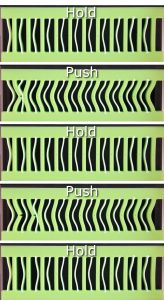How to make a block of rubber count to ten
A block of rubber that counts to ten and even remembers in which sequence it was compressed. Physicists Martin van Hecke and Lennard Kwakernaak (Leiden and AMOLF Amsterdam) share a fascination for complexity in simple objects. They wrote an article about a counting block of rubber, which they classify as a metamaterial, and published it in the journal Physical Review Letters.
PhD student Kwakernaak enters the room with a big smile on his face and carrying his showpiece: a block of soft rubber with 22 small interconnecting bars. “This is our metamaterial. Why don’t you try pressing it”, he encourages us. The result is unexpected. The bars all bend to the left, except for the first one, which bends to the right. “The first bar then presses the second one to the right, followed by the third one. Each time you press it another bar buckles until the material has counted to ten.”
A material with memory
The block of rubber is an example of a mechanical metamaterial: the properties of this material are determined not only by its molecular composition, but also by its structure. The group of van Hecke researches how to process information using such metamaterials, comparable to how a computer operates. A small bar that buckles from left to right is somewhat like a computer bit, which can be either one or zero. “It isn’t easy to design the structure so that it responds how we want”, adds Kwakernaak. “Counting is the simplest calculation we could think of, so this was a logical starting point.”

Simple solutions for a range of problems
The question is of course, why would you make a block of rubber count if we can also do this with computers? An application you can think of is counting cars in different weight classes while they drive over a bridge without using an energy source to do so. Or another example: a step counter, because you can make the metamaterial as big or small as you want to. “The main advantage of such mechanical metamaterials is that they are cheap, robust and require little maintenance”, says Kwakernaak. “This makes them interesting for various applications. It’s hard for us to say which purpose they will serve, but we know that such new materials always turn out to be useful. Earlier research on origami folding has inspired engineers to design solar panels that fold in space.”
What interests Kwakernaak the most is to see how simple things can behave in a very complex manner. “The way in which such a thin bar buckles is much more complicated than you might think. A computer is barely able to simulate it.” He smiles: “it feels almost like I am a professional hobbyist.” His next step is to think of a more complicated structure that is not limited to one direction, but which operates on a surface. “This basically means that it’s a simple computer.”
Reference
Lennard J. Kwakernaak and Martin van Hecke, Counting and Sequential Information Processing in Mechanical Metamaterials, Physical Review Letters, 130, 268204, 30 June (2023).
https://doi.org/10.1103/PhysRevLett.130.268204


